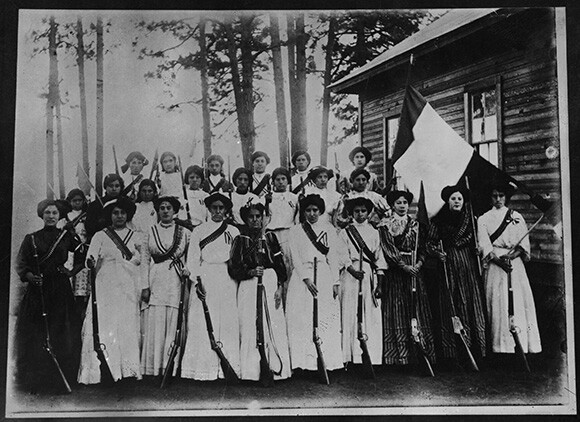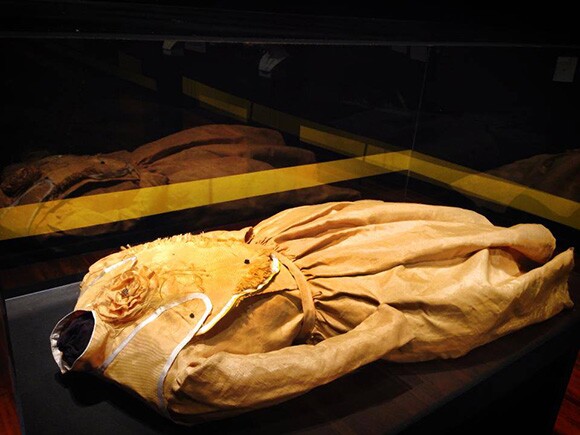Nao Bustamante's Soldaderas, Real and Imagined

Inspired by Nao Bustamante's exhibition, Soldadera -- the artist's "speculative reenactment" of women's participation on the front lines of The Mexican Revolution -- Artbound is publishing articles about the exhibition's development, historical contexts engaged by this project, and writing inspired by the work. Soldadera was guest curated for the Vincent Price Art Museum by UC Riverside professor Jennifer Doyle.
The national mood is one of perpetual, escalating insecurity. Bodies are at risk, and bodies represent risk. We are surrounded by more prisons and walls, more tuition, more ID checks, more crisis. We take to the streets chanting "We can't breathe" to cut through the caterwaul of tragic news headlines that would make the escalation of the crisis seem unstoppable. In those moments of pounding pavement together, shutting down freeways, setting up camp in a city square, it feels as if the world can actually change.
From the streets of Baltimore to Los Angeles' Skid Row, a sense of outrage and despair is cut with moments of revolt, and the glimpse of another world. We swing from one feeling (everything is impossible) to the other (things can change) and back again.
Nao Bustamante's bullet-proof gown, "Tierra y Libertad - Kevlar® 2945," offers us a metaphorical shield for surviving a world that feels like it is perpetually at war. When she first began to entertain the idea of making a dress that would protect its wearer from harm, she came across a photographic portrait of a battalion of women who fought in the Mexican Revolution. This apparently incongruous image of armed women dressed in Edwardian gowns inspired the artist to center her exploration of the art of "personal protection" on the figure of the soldadera, the Mexican revolutionary woman fighter.
test shoot for "Tierra y Libertad" from Nao Bustamante on Vimeo.
The video "Test Shoot" tracks the artist's uneasy juxtaposition of the appearance of feminine vulnerability, contemporary security technology, and the simple geometries of violence. Bustamante directly poses the question: "Clad in an Edwardian combat dress made of Kevlar®, how would a woman fighting in the Mexican Revolution stand up to the weaponry of 1910?" The question is answered by shooting the dress itself. The history of the fabric's encounter with the rifle is integral to its display: the dress is exhibited under glass, as the garment of a fallen warrior. Bullets are now embedded in its apron.
The dress acts as a punctuation point in the everyday conversation about vulnerable bodies, a moment to stop and reflect: How do we protect ourselves without escalating the violence directed at us? What does it mean to secure the body, completely? What does it mean to do the opposite, to open the body up? To be vulnerable?

Bustamante has long made work that explores exposure, and vulnerability. She spent much of her 2002 performance "America the Beautiful" nude, wrapped in packing tape, and perched precariously on a ladder in high heels. Her video installation "Neopolitan" centers on a looped video of the artist weeping. In the 2009 piece, "Given Over to Want," she wobbles on high heels made of fruit, laps up wine -- which spills from a box taped to her head like a hat and generally disintegrates in a performance of hunger and need. The late critical theorist José Muñoz, borrowing a term from Kafka, describes her as a "vulnerability artist." He writes:
Bustamante's performance practice engages and re-imagines what has been a history of violence, degradation, and compulsory performance. For a female artist of color to engage this field is not only historically loaded, it is also extremely vulnerable making.1
Perhaps this work with exposure launched her interest in creating a Kevlar dress: even as it promises a certain level of protection, the bullet-proof dress does not leave the viewer feeling that the person wearing it is fully secured. Instead, the dress identifies its wearer as a moving target. It allegorizes the awfulness of security logics, especially as they wrap themselves around a vulnerable and feminine body.

The making of this dress set Bustamante and I on a journey. I fell in love with the Kevlar® dress when I first saw it in a group exhibition of contemporary art exploring the myths of the Mexican Revolution. At the time, I was just starting to write a book about campus security. Bustamante was researching women's participation in the Mexican Revolution. We are friends, and began talking about gender, vulnerability, and feeling exposed. As it happens, Special Collections and University Archives at the University of California Riverside, where I work, has a substantial collection of photographs of the Mexican Revolution. I invited her to be an artist-in-residence at UCR, and dedicated one of my classes to her work. While I surveyed Bustamante's career in the classroom, she was on the other end of the campus, exploring the photographic traces of the soldadera in the library archives. Images of women are relatively rare in the visual record of the Mexican Revolution, and they are scattered across the collection. They are the subject of portraits like the one which inspired the dress, but they also appear hurrying, alone, down battle-torn streets or they appear in large groups, washing an army's clothes at a river's edge. This visual research provides the creative foundation for "Soldadera," an exhibition of Bustamante's works at the Vincent Price Museum of art, which I curated.

Soldaderas played no small part in the long war that established the nation that we know today. They cared for whole armies, and for their children. They joined the struggle as support troops, they took up arms, they nursed the living and buried the dead. When it came to their own welfare, however, soldaderas had to look out for themselves. They endured all that men endure in war, and more. These women had to fight, and the "front," for the vulnerable, may be one's home and one's own body.
The literature documenting their experiences might be sparse -- histories of nation-formation rarely center on women, no matter how important their role might have been -- but the stories we do have are intense.
Nicolás Durán, a soldier who fought for Pancho Villa, writes "When I remember the Revolution I find very deep within me a sacred sentiment, a sort of veneration, for the Mexican woman." That statement would seem quite traditional if it were just a matter of placing women on a pedestal. But the root of veneration grows from seeing "thousands of dead women in the battle field."2 That veneration has additional force when balanced with the straightforward recollections of soldaderas themselves. "What do soldiers care of consent?" recalls Jesusa, the subject of Elena Poniatowska's testimonial novel recording the experiences of one of these miraculous women. Women might be conscripted into the army, as men were, but there was at times no end to the way in which their bodies were available to not only the enemy, but to the very men they supported.3 The recollections of women themselves suggest a story that is both magical and ordinary, heroic and anti-heroic.
The project took a dramatic turn in January when Bustamante's research led to a pilgrimage to Zapopan, Mexico in order to meet an actual soldadera, Leandra Becarra Lumbreras. At the time of their meeting, Lumbreras was the oldest person in the world and the last survivor of the Mexican Revolution. Born in Tamaulipas, Mexico in 1887, when she died in Zapopan in March, she was 127 years old. Bustamante's exhibition was inspired as much by her time with Lumbreras as it was by the images in the university's archive: to be in Lumbreras's company was to experience a different relationship to time.


Bustamante's exhibition outfits an army of visionaries in a cinematic fusion of a utopian past and present. Archival photographs are cut into a film installation that "dips a ladle" into the script for an unfinished film by the Russian revolutionary filmmaker Sergei Eisenstein; another work invites the viewer into a virtual encounter with the last surviving soldadera and the oldest person in the world. As the artist puts it, "Soldadera" is an exercise in "speculative reenactment" in which the artist "time travels" the historical soldadera in a deliberate confusion of past, present and future. Bustamante pursues an imaginative dialogue with the soldadera, slipping into the soldadera's mythic past as if it were a dress, in order to conjure a different future for the woman warrior. Our intention, as artist and curator, is to invite the viewer of the exhibition and the readers of this article series to consider the possibilities of speculative, even utopian thinking as a not a retreat from the here-and-now, but as a deep engagement with how we might imagine the here-and-now differently.
1José Muñoz, "The Vulnerability Artist: Nao Bustamante and the Sad Beauty of Reparation" in Women and Performance, Vol. 16, No. 2 (July 2006), 191-200, 194.
2Nicolas Durán's recollection is included in Mark Wasserman's resource guide The Mexican Revolution: A Brief History with Documents (Bedford/St. Martins, 2012), 81-84, 82. Waserman's text is a good introduction to the history of this war.
3Elena Poniatowska, Here's to You, Jesusa!, trans. Deanna Heikkinen (New York: Penguin, 2002), 82. Originally published as Hasta no verte Jesús mío by Ediciones Era, Mexico, 1969.
Soldadera is on view at the Vincent Price Art Museum from May 16 until August 1. Opening reception: Saturday, May 16 from 4 p.m.- 6 p.m. A curator's walk-through is scheduled at noon on May 22.
Dig this story? Sign up for our newsletter to get unique arts & culture stories and videos from across Southern California in your inbox. Also, follow Artbound on Facebook, Twitter, and Youtube.